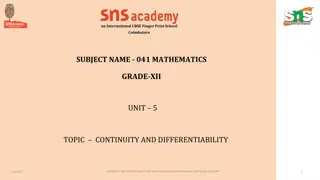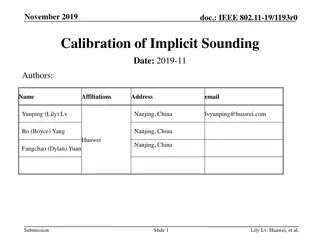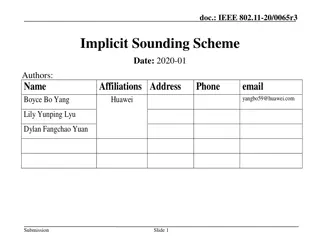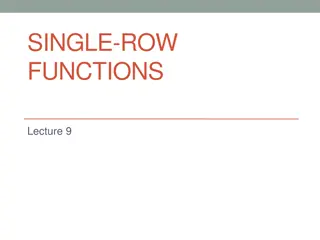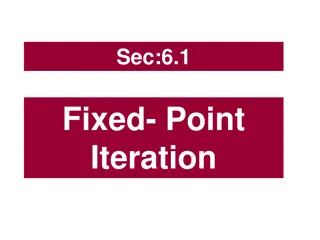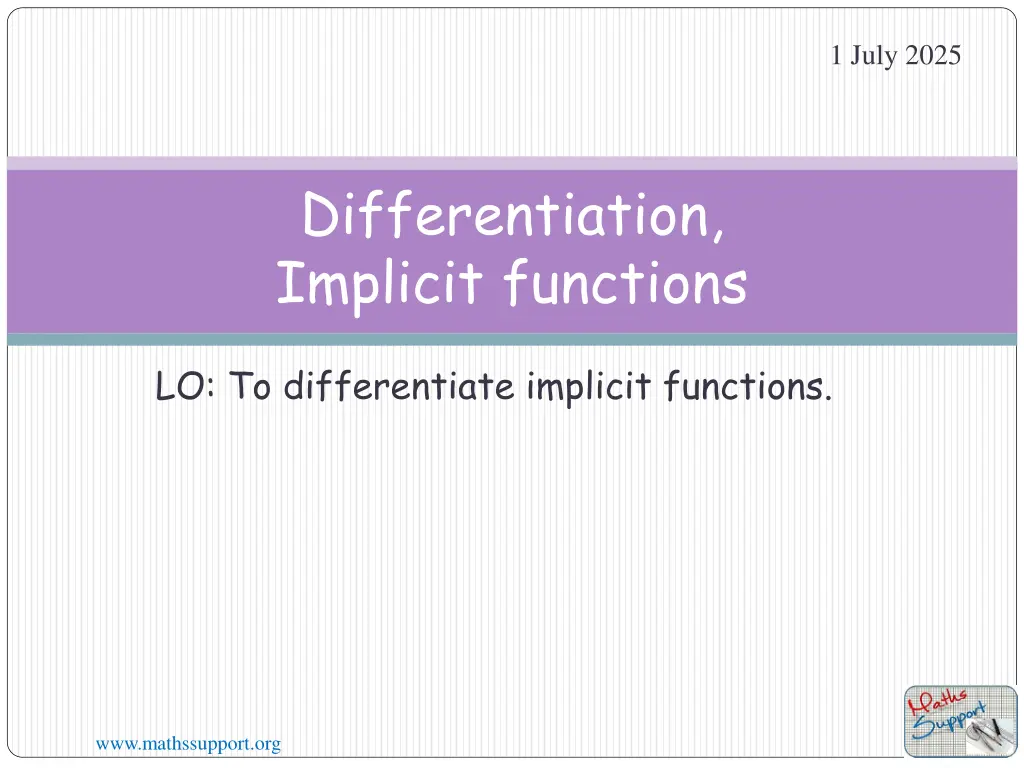
Implicit Differentiation Methods
Learn about implicit functions and how to differentiate them using implicit differentiation. Discover techniques to express implicit functions as explicit functions and solve differentiation problems step by step. Improve your understanding of differentiation with examples and practical exercises.
Download Presentation

Please find below an Image/Link to download the presentation.
The content on the website is provided AS IS for your information and personal use only. It may not be sold, licensed, or shared on other websites without obtaining consent from the author. If you encounter any issues during the download, it is possible that the publisher has removed the file from their server.
You are allowed to download the files provided on this website for personal or commercial use, subject to the condition that they are used lawfully. All files are the property of their respective owners.
The content on the website is provided AS IS for your information and personal use only. It may not be sold, licensed, or shared on other websites without obtaining consent from the author.
E N D
Presentation Transcript
1 July 2025 Differentiation, Implicit functions LO: To differentiate implicit functions. www.mathssupport.org
Review of differentiation So far, we have been working with functions where the dependent variable y is a function of the independent variable x. We express y in terms of x. For example, y = x2 + 1 We are defining y explicitly in terms of x. If this is the case, we say that y is an explicit function of x. If the relationship between the function y and the variable x is expressed by an equation where y is not expressed entirely in terms of x, we say that the equation defines y implicitly in terms of x. The function y x2 = 1 Defines implicitly the function y = x2 + 1 www.mathssupport.org
Implicit functions You can often change an implicitly defined function into an explicit function by expressing one variable in terms of the other. From the list, identify functions that are not easy to express as explicit functions. 2x2 + y3 = 1 2x + 3y = 8 x + x2y + y3 = 100 x3 2xy = 5y 5x2 + y = 2 To differentiate functions where is often difficult or impossible to make y the subject of the formula we have use a method called implicit differentiation www.mathssupport.org
Implicit differentiation Example 1: Differentiate y2 = 4xwith respect to x We can write the function explicitly. y2 = 4x 2 x y = 4x = Differentiating Differentiating Taking y =2 x Taking y = 2 x 1 2 1 2 y = 2? ?? ?? y = 2? ?? ?? 2 2 ? 1 ? 1 1 2 1 2 = (2) = ( 2) = = 2 2 2 x 2 x ?? ??= ?? ??= 2 2 y y www.mathssupport.org
Implicit differentiation In this case it was easy to convert into an implicit function and differentiate but, is not always that easy. So, we have to use a method to differentiate implicit functions. To perform implicit differentiation on an equation that defines a function y implicitly in terms of a variable x, use the following steps 1. Take the derivative of both sides of the equation. Keep in mind that y is a function of x. 2. Rewrite the equation so that all the terms containing ?? on the left and all the terms that do not contain ?? the right. 3. Factor out ?? ?? are ??are on ?? on the left if needed. ?? on the left dividing both sides of the equation by an appropriate algebraic expression. 4. Solve for ?? www.mathssupport.org
Implicit differentiation Example 1: Differentiate y2 = 4ximplicitly with respect to x Step 1. Differentiate both sides of the equation. Differentiate the left-hand side. Differentiate the right-hand side ?(4?) ?? ? ?2 ?? = ? ?2 ?? ?? ?? Note that using the chain rule ? ?? ?? ?? = 4 ? ?? ?? ?? =nyn 1?? = ?? 2y?? = 4 ?? Step 2. Keep the terms with ?? ?? on the left and move all the other terms to the right. 2y?? ??= 4 Does not apply Step 3. Factor out ?? ?? on the left if needed. Step 4. Solve for ?? ?? on the left dividing both sides of the equation by 2y ?? ??= 4 2 = y 2y www.mathssupport.org
Implicit differentiation Example 2:Differentiatex2 + y2 = 4 implicitly with respect to x Step 1. Differentiate both sides of the equation. We simply differentiate term by term across the equation. x2 + y2 = 4 ? ?2 ?? ? ?2 ?? ?(4) ?? + = Note that using the chain rule ? ?? ?? ?? ? ?2 ?? ?? ??= 0 ?? ?? ? ?? ?? ?? =nyn 1?? 2x + = ?? 2y 2x + = 0 Step 2. Keep the terms with ?? ?? on the left and move all the other terms to the right. ?? ??= 2y 2x Does not apply Step 3. Factor out ?? ?? on the left if needed. Step 4. Solve for ?? ?? on the left dividing both sides of the equation by 2y ?? ??= 2x x = y 2y www.mathssupport.org
Implicit differentiation Example 3: Differentiatex2 + y3 = 8 implicitly with respect to x Step 1. Differentiate both sides of the equation. x2 + y3 = 8 ? ?3 ?? ?? ?? ? ?2 ?? ?(8) ?? + = Note that using the chain rule ? ?? ?? ?? ? ?? ?? ?? =nyn 1?? 3y2 = 2x + = 0 ?? Step 2. Keep the terms with ?? ?? on the left and move all the other terms to the right. ?? ??= 3y2 2x Does not apply Step 3. Factor out ?? ?? on the left if needed. Step 4. Solve for ?? ?? on the left dividing both sides of the equation by 3y2 ?? ??= 2x 3y2 www.mathssupport.org
Implicit differentiation and the product rule Example 4: Differentiatex + x2y + y3 = 100 implicitly with respect to x Step 1. Differentiate both sides of the equation. Using the rule Using the product rule u= x2 ?? ??= 2x ? ?2? ?? v = y ?? ??=?? ?? ??+ x + x2y + y3 = 100 ? ?3 ?? 3y2?? ?? ? ?? ?? =ny n 1?? ? ?2? ?? ?(100) ?? ? ? ??+ ?? + = ?? ?? ??+ + y 2x x2 1 = 0 + y 2x x2 = Step 2. Keep the terms with ?? ?? on the left and move all the other terms to the right. ?? ?? x2?? ?? ?? on the left if needed. 3y2 + 1 2xy = Step 3. Factor out ?? ?? ?? (x2 + 3y2) 1 2xy = Step 4. Solve for ?? ?? on the left dividing both sides of the equation by (x2 + 3y2) ?? ??= 1 2xy x2 + 3y2 www.mathssupport.org
Implicit differentiation and the product rule Example 5: Differentiatex3 + y3 9xy = 0 implicitly with respect to x Step 1. Differentiate both sides of the equation. Using the rule Using the product rule u= 9x ?? ??= 9 ? 9xy ?? x3 + y3 9xy = 0 ? ?3 ?? v = y ?? ??=?? ?? ??+ ? ?? ?? =ny n 1?? ? 9xy ?? ?? ?? ? x3 ?? ?(0) ?? ?? + = ?? ?? ?? 3x2 3y2 9x + 9y =0 y 9 9x = Step 2. Keep the terms with ?? ?? on the left and move all the other terms to the right. ?? ?? ?? ?? 3x2 9x 9y 3y2 = Step 3. Factor out ?? ?? on the left if needed. ?? ?? 9y 3x2 (3y2 9x) = Step 4. Solve for ?? ?? on the left dividing both sides of the equation by (3y2 9x) =3y x2 ?? ??=9y 3x2 (3y x2) 3 3 = y2 3x (y2 3x) 3y2 9x www.mathssupport.org
Implicit differentiation and the product rule Example 6: Differentiatex3sin y + y = 4x + 3 implicitly with respect to x Step 1. Differentiate both sides of the equation. Using the product rule Using the rule u = x3 ?? ??= 3x2 cos??? ?? v =sin y ?? ??=cos??? x3sin y + y = 4x + 3 ? ? ?? 3x2sin y ?? =ny n 1?? ? ?? ?? ? 3 ?? ? x3sin y ?? =?(4?) ?? + + ?? ?? ? x3sin y ?? ?? ?? sin y x3 3x2 = ??+ x3cos? + + 0 4 = + Step 2. Keep the terms with ?? ?? on the left and move all the other terms to the right. ?? ?? ?? ?? x3cos? + 3x2sin y 4 = Step 3. Factor out ?? ?? on the left if needed. ?? ?? (x3cos? + 1) 4 3x2sin y = Step 4. Solve for ?? ?? on the left dividing both sides of the equation by (x3cos? + 1) ?? ??=4 3x2sin y x3cos? + 1 www.mathssupport.org
Finding the Equation of the Tangent Line to a Curve Example 7: The point P(2, a), wherea < 0, lies on the curve 2x2y + 3y2 = 16 (a) Calculate the value of a. Substitute (2, a) into the implicit function for (x, y). 2x2y + 3y2 = 16 + 2(2)2(a) 3(a)2 16 = 8a + + 3a2 16 16 0 = = 3a2 8a Ordering the quadratic equation (3a 4) (a + 4) = 0 Factorising a + 4 = 0 a = 4 3a 4 or or Solving for a = 0 4 3 a = a = 4 Sincea < 0, www.mathssupport.org
Finding the Equation of the Tangent Line to a Curve Example 7: The point P(2, m), wherem < 0, lies on the curve 2x2y + 3y2 = 16 (b) Find the slope of the tangent at P. 2x2y + 3y2 = 16 ? 3y2 ?? ?? ?? + Differentiate implicitly Using the rule Using the product rule u= 2x2 ?? ??= 4x ? 2x2y ?? ?(16) ?? = + v = y ?? ??= ? ?? ?? ?? ?? =ny n 1 ?? ?? ?? ?? 0 y 2x2 6y + 4x = ?? ??= ?? ?? 4xy ? 2?2? ?? + 6y ?? ??+ 2x2 y Rearranging 4x 2x2 = ?? ?? = ?? ?? = 4xy (2x2 + 6y) 4xy Factorising Rearranging 2x2 + 6y = 4(2)(-4) ?? ??(2, 4) = 2 At P(2, -4) 2(2)2 + 6(-4) www.mathssupport.org
Finding the Equation of the Tangent Line to a Curve Example 7: The point P(2, m), wherem < 0, lies on the curve 2x2y + 3y2 = 16 (c) Find the equation of the normal to the tangent at P. ?? ??(2, 4) = 2 The gradient of the tangent at P (2, -4) is: 1 2 Hence, the slope of the normal at P is: Substitute into the point-slope equation of the line to obtain =1 (x 2) (y ( 4)) 2 y + 4 =1 2? 1 Simplifying y=1 2? 5 Rearranging www.mathssupport.org
Thank you for using resources from A close up of a cage Description automatically generated For more resources visit our website https://www.mathssupport.org If you have a special request, drop us an email info@mathssupport.org www.mathssupport.org

